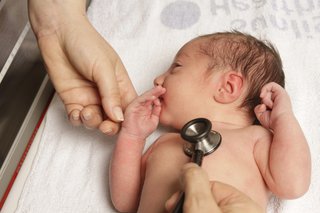All parents are offered a thorough physical examination for their baby within 72 hours of giving birth.
The examination includes screening tests to find out if your baby has any problems with their eyes, heart, hips and, in boys, testicles (testes).
What is the newborn physical examination?
The newborn physical examination is usually carried out in hospital before you go home.
Sometimes it's done at a hospital or community clinic, GP surgery, children's centre or at home. Ideally, both parents should be there when the examination is done.
The healthcare professional doing the examination should explain what it involves. This could be a doctor, midwife, nurse or health visitor who's been trained to do the examination.
Some parts of the examination may be a bit uncomfortable for your baby, but it will not cause them any pain.
The aim is to spot any problems early so treatment can be started as soon as possible. Usually, nothing of concern is found.
If the healthcare professional doing the examination does find a possible problem, they may refer your baby for more tests.
You'll be offered another physical examination for your baby at 6 to 8 weeks, as some of the conditions it screens for can take a while to develop.
This 2nd examination is usually done at your GP surgery.

How is the newborn physical examination done?
The healthcare professional will give your baby a thorough physical examination.
They'll also ask you questions about how your baby is feeding, how alert they are, and about their general wellbeing.
Your baby will need to be undressed for part of the examination.
During the examination, the healthcare professional will also:
- look into your baby's eyes with a special torch to check how their eyes look and move
- listen to your baby's heart to check their heart sounds
- examine their hips to check the joints
- examine baby boys to see if their testicles have descended into the scrotum
What does the newborn physical examination check for?
The examination includes an overall physical check, plus 4 different screening tests.
Eyes
The health professional will check the appearance and movement of your baby's eyes.
They're looking for cataracts, which is a clouding of the transparent lens inside the eye, and other conditions.
About 2 or 3 in 10,000 babies are born with cataracts in one or both eyes that need treatment.
But the examination cannot tell you how well your baby can see.
Find out more about childhood cataracts
Heart
The healthcare professional will check your baby's heart. This is done by observing your baby, feeling your baby's pulses, and listening to their heart with a stethoscope.
Sometimes heart murmurs are picked up. A heart murmur is where the heartbeat has an extra or unusual sound caused by a disturbed blood flow through the heart.
Heart murmurs are common in babies. The heart is normal in almost all cases where a murmur is heard.
But about 8 in 1,000 babies have congenital heart disease that needs treatment.
Find out more about congenital heart disease
Hips
Some newborns have hip joints that are not formed properly. This is known as developmental dysplasia of the hip (DDH).
Left untreated, DDH can cause a limp or joint problems.
About 1 or 2 in 1,000 babies have hip problems that need to be treated.
Find out more about developmental dysplasia of the hip
Testicles
Baby boys are checked to make sure their testicles are in the right place.
During pregnancy, the testicles form inside the baby's body. They may not drop down into the scrotum until a few months after birth.
Around 2 to 6 in 100 baby boys have testicles that descend partially or not at all.
This needs to be treated to prevent possible problems later in life, such as reduced fertility.
Does my baby have to have the examination?
The aim of the examination is to identify any of the problems early so treatment can be started as soon as possible.
It's strongly recommended for your baby, but not compulsory.
You can decide to have your baby examined and screened for any or all of the conditions.
If you have any concerns, you should talk to your midwife or the healthcare professional offering the examination.
When will we get the results?
The healthcare professional who does the examination will give you the results straight away.
If your baby needs to be referred for more tests, they'll discuss this with you there and then, too.
The results will be recorded in your baby's personal child health record (red book).
You'll need to keep this safe and have it to hand whenever your baby sees a healthcare professional.
If you have any concerns, you can discuss them with your midwife or the healthcare professional who does the examination.
Download a leaflet about screening tests for you and your baby from GOV.UK